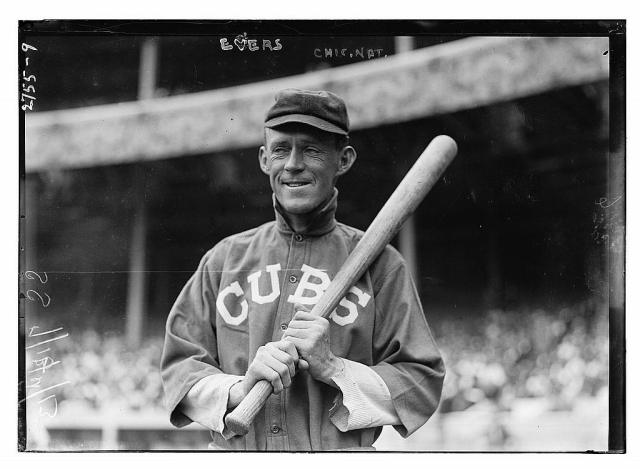The Unassisted Triple Play
Shortstop Joe Tinker, second baseman Johnny Evers, and first baseman Frank Chance were the most famous double-play trio in baseball history. They succeeded by being well prepared, aware of the game's situation, and lucky.

I periodically send notes to my entire team sharing details of what I'm working on individually, updates on major company initiatives, and what I hope are thought-provoking themes and ideas. These notes are one mechanism to help with communication and stay engaged with a large staff. My general approach is to write about three or four topics and create an unusual headline for the subject of the email, in hopes of grabbing attention and getting folks to read it. Here are a few examples:
"Brand Camp, Performance reviews, and a sneaky reminder about SBC [Standards of Business Conduct] training"
"Advisory boards, G8, and 3rd remote worker forum"
"Why we care about Doritos, Beer, Bananas, and laundry detergent"
"A call to action, 3rd annual RWF, and the unassisted triple play"
Today I want to expand a bit on one of these themes, the unassisted triple play (And no, I'm not talking about cable, phone, and TV bundles).
A recurring theme in my thinking these past many weeks relate to aspirations. We have a lot of initiatives underway, and nearly all of them are part of a long-term strategy that is defined by an aspirational goal. Sharing the end-state vision allows us to validate that the work we're doing today will line up with that future target. Aspirations take the form of cultural, organizational, and service-delivery goals, and for me, they evolve as we chart our course and learn from the work we undertake.

Johnny Evers was a second baseman and part of the most famous double-play trio in baseball history (shortstop Joe Tinker, second baseman Johnny Evers, and first baseman Frank Chance). The group made their first double play in the 1902 season for the Cubs and are immortalized in a poem by New York Giant fan and sportswriter Franklin Pierce Adams entitled Baseball's Sad Lexicon.
These are the saddest of possible words:
"Tinker to Evers to Chance."
Trio of bear cubs, and fleeter than birds,
Tinker and Evers and Chance.
Ruthlessly pricking our gonfalon bubble,
Making a Giant hit into a double-
Words that are heavy with nothing but trouble:
"Tinker to Evers to Chance."
-Published in New York Evening Mail (July 10, 1910)
Unassisted Triple Play
This past weekend, like most weekends in the Spring and Fall, I spent a lot of time on the softball field coaching and watching my two girls play. This past weekend I witnessed an amazing unassisted triple play. An unassisted triple play is when a single fielder makes all three outs in the inning in one continuous play without the help of any of her teammates. This play favors the middle infielders, shortstop and second base, and predominately happens when a line drive or pop fly is caught for out number one. The fielder then tags a base runner for out two and beats the other base runner back to the original base for the third out.
To share how rare this event is, there have only been 15 unassisted triple plays in Major League baseball since 1909. Stunningly, two of these occurred within 24 hours of each other in 1927. The next didn’t happen for 41 years. Granted these girls are high school players, but it’s not neighborhood ball anymore, they are competitive and it was an amazing play and sight to see. I was thinking about how this play parallels our TechOps aspirational mindset.
Three things need to culminate for an unassisted triple play:
1. Situational
To be eligible for a triple play to happen there must be no outs in the inning and at least two base runners need to be on the bases. This alone is enough to make the event rare, think about how few times in a game two base runners are on base with no outs, this is a small window in any baseball or softball game. The batter then needs to hit a ball to the infield in the air. Very likely the hit needs to be directly to a fielder to give them time, assuming she makes the initial catch, to make the remaining two outs. Situation matters, and being aware of the situation you’re in matters too. Are we situationally aware for the next play we need to make? We can’t expect a triple play, but we should be preparing ourselves ahead of time for the next move. This is what I mean when I talk about being proactive.
2. Heads up play
The fielder needs to know who’s on base and where to make the play. Combining situational knowledge with quick reactions is essential. The fielder needs to have the skill to execute the catch, the tag, and the sprint. If their muscles aren’t trained, if their weight is back on their heels, if they have doubt they can make the play; they won’t. Do we have our heads in the game and are we ready to make the play? When we’re called on to catch the ball, to install code, to handle increased capacity, are we ready? Have we trained our minds for what’s about to come and are we ready to face the challenge in the moment or do we need to call time and regroup?
3. Luck
There is no doubt luck plays a huge role in the unassisted triple play. However, I believe you get to make a bit of your own luck by being prepared to seize the moment when that opportunity arises. The fielder who makes a “lucky” catch was likely doing somethings right. If she hadn’t opened her glove, or sprinted hard to where the ball was going, she wouldn’t have been giving herself every opportunity to be successful. We can’t control everything, but we can take advantage of a situation and capitalize on the line drive hit right to us, maybe by turning a double or triple play. If you believe you can influence luck, then you might also agree it can work the other way. A consistent coaching subject I use with my girls is to not defeat yourself before the game has even begun. Visualize what needs to be done and then go about the business of doing it. Seeing success breeds success.
One last note: While an unassisted triple play is an amazing feat. Making a triple play with the help of your teammates is pretty darn impressive too. There have only been 696 triple plays in MLB ever (1876 – 2014). The most recent triple play happened just days ago on September 14, 2014 by the Pittsburgh Pirates vs the Chicago Cubs.
If you need help from your teammates and colleagues to make a triple play, there is no shame, we’re all on the same team.
Play ball.




